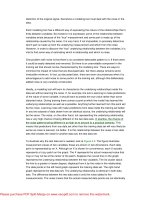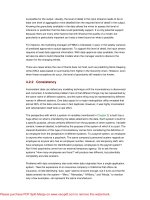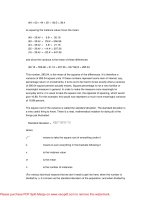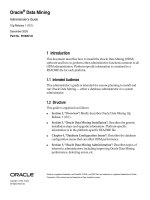Data Mining Anomaly Detection docx
Bạn đang xem bản rút gọn của tài liệu. Xem và tải ngay bản đầy đủ của tài liệu tại đây (381.17 KB, 24 trang )
Data Mining
Anomaly Detection
Lecture Notes for Chapter 10
Introduction to Data Mining
by
Tan, Steinbach, Kumar
© Tan,Steinbach, Kumar Introduction to Data Mining 1
© Tan,Steinbach, Kumar Introduction to Data Mining 2
Anomaly/Outlier Detection
What are anomalies/outliers?
–
The set of data points that are considerably different than the
remainder of the data
Variants of Anomaly/Outlier Detection Problems
–
Given a database D, find all the data points x ∈ D with anomaly
scores greater than some threshold t
–
Given a database D, find all the data points x ∈ D having the top-
n largest anomaly scores f(x)
–
Given a database D, containing mostly normal (but unlabeled)
data points, and a test point x, compute the anomaly score of x
with respect to D
Applications:
–
Credit card fraud detection, telecommunication fraud detection,
network intrusion detection, fault detection
© Tan,Steinbach, Kumar Introduction to Data Mining 3
Importance of Anomaly Detection
Ozone Depletion History
In 1985 three researchers (Farman,
Gardinar and Shanklin) were puzzled
by data gathered by the British
Antarctic Survey showing that ozone
levels for Antarctica had dropped
10% below normal levels
Why did the Nimbus 7 satellite, which
had instruments aboard for recording
ozone levels, not record similarly low
ozone concentrations?
The ozone concentrations recorded by
the satellite were so low they were
being treated as outliers by a
computer program and discarded!
Sources:
/>© Tan,Steinbach, Kumar Introduction to Data Mining 4
Anomaly Detection
Challenges
–
How many outliers are there in the data?
–
Method is unsupervised
•
Validation can be quite challenging (just like for
clustering)
–
Finding needle in a haystack
Working assumption:
–
There are considerably more “normal”
observations than “abnormal” observations
(outliers/anomalies) in the data
© Tan,Steinbach, Kumar Introduction to Data Mining 5
Anomaly Detection Schemes
General Steps
–
Build a profile of the “normal” behavior
•
Profile can be patterns or summary statistics for the overall
population
–
Use the “normal” profile to detect anomalies
•
Anomalies are observations whose characteristics
differ significantly from the normal profile
Types of anomaly detection
schemes
–
Graphical & Statistical-based
–
Distance-based
–
Model-based
© Tan,Steinbach, Kumar Introduction to Data Mining 6
Graphical Approaches
Boxplot (1-D), Scatter plot (2-D), Spin plot (3-D)
Limitations
–
Time consuming
–
Subjective
© Tan,Steinbach, Kumar Introduction to Data Mining 7
Convex Hull Method
Extreme points are assumed to be outliers
Use convex hull method to detect extreme values
What if the outlier occurs in the middle of the data?
© Tan,Steinbach, Kumar Introduction to Data Mining 8
Statistical Approaches
Assume a parametric model describing the
distribution of the data (e.g., normal distribution)
Apply a statistical test that depends on
–
Data distribution
–
Parameter of distribution (e.g., mean, variance)
–
Number of expected outliers (confidence limit)
© Tan,Steinbach, Kumar Introduction to Data Mining 9
Grubbs’ Test
Detect outliers in univariate data
Assume data comes from normal distribution
Detects one outlier at a time, remove the outlier,
and repeat
–
H
0
: There is no outlier in data
–
H
A
: There is at least one outlier
Grubbs’ test statistic:
Reject H
0
if:
s
XX
G
−
=
max
2
2
)2,/(
)2,/(
2
)1(
−
−
+−
−
>
NN
NN
tN
t
N
N
G
α
α
© Tan,Steinbach, Kumar Introduction to Data Mining 10
Statistical-based – Likelihood Approach
Assume the data set D contains samples from a mixture of
two probability distributions:
–
M (majority distribution)
–
A (anomalous distribution)
General Approach:
–
Initially, assume all the data points belong to M
–
Let L
t
(D) be the log likelihood of D at time t
–
For each point x
t
that belongs to M, move it to A
•
Let L
t+1
(D) be the new log likelihood.
•
Compute the difference, ∆ = L
t
(D) – L
t+1
(D)
•
If ∆ > c (some threshold), then x
t
is declared as an anomaly
and moved permanently from M to A
© Tan,Steinbach, Kumar Introduction to Data Mining 11
Statistical-based – Likelihood Approach
Data distribution, D = (1 – λ) M + λ A
M is a probability distribution estimated from data
–
Can be based on any modeling method (naïve
Bayes, maximum entropy, etc)
A is initially assumed to be uniform distribution
Likelihood at time t:
∑∑
∏∏∏
∈∈
∈∈=
+++−=
−==
ti
t
ti
t
ti
t
t
ti
t
t
Ax
iAt
Mx
iMtt
Ax
iA
A
Mx
iM
M
N
i
iDt
xPAxPMDLL
xPxPxPDL
)(loglog)(log)1log()(
)()()1()()(
||||
1
λλ
λλ
© Tan,Steinbach, Kumar Introduction to Data Mining 12
Limitations of Statistical Approaches
Most of the tests are for a single attribute
In many cases, data distribution may not be known
For high dimensional data, it may be difficult to
estimate the true distribution
© Tan,Steinbach, Kumar Introduction to Data Mining 13
Distance-based Approaches
Data is represented as a vector of features
Three major approaches
–
Nearest-neighbor based
–
Density based
–
Clustering based
© Tan,Steinbach, Kumar Introduction to Data Mining 14
Nearest-Neighbor Based Approach
Approach:
–
Compute the distance between every pair of
data points
–
There are various ways to define outliers:
•
Data points for which there are fewer than p
neighboring points within a distance D
•
The top n data points whose distance to the kth
nearest neighbor is greatest
•
The top n data points whose average distance to
the k nearest neighbors is greatest
© Tan,Steinbach, Kumar Introduction to Data Mining 16
Outliers in Lower Dimensional Projection
Divide each attribute into φ equal-depth intervals
–
Each interval contains a fraction f = 1/φ of the records
Consider a k-dimensional cube created by picking grid
ranges from k different dimensions
–
If attributes are independent, we expect region to
contain a fraction f
k
of the records
–
If there are N points, we can measure sparsity of a
cube D as:
–
Negative sparsity indicates cube contains smaller
number of points than expected
© Tan,Steinbach, Kumar Introduction to Data Mining 17
Example
N=100, φ = 5, f = 1/5 = 0.2, N × f
2
= 4
© Tan,Steinbach, Kumar Introduction to Data Mining 18
Density-based: LOF approach
For each point, compute the density of its local neighborhood
Compute local outlier factor (LOF) of a sample p as the average
of the ratios of the density of sample p and the density of its
nearest neighbors
Outliers are points with largest LOF value
p
2
×
p
1
×
In the NN approach, p
2
is
not considered as outlier,
while LOF approach find
both p
1
and p
2
as outliers
© Tan,Steinbach, Kumar Introduction to Data Mining 19
Clustering-Based
Basic idea:
–
Cluster the data into
groups of different density
–
Choose points in small
cluster as candidate
outliers
–
Compute the distance
between candidate points
and non-candidate
clusters.
•
If candidate points are far
from all other non-candidate
points, they are outliers
© Tan,Steinbach, Kumar Introduction to Data Mining 20
Base Rate Fallacy
Bayes theorem:
More generally:
© Tan,Steinbach, Kumar Introduction to Data Mining 21
Base Rate Fallacy (Axelsson, 1999)
© Tan,Steinbach, Kumar Introduction to Data Mining 22
Base Rate Fallacy
Even though the test is 99% certain, your chance of
having the disease is 1/100, because the
population of healthy people is much larger than
sick people
© Tan,Steinbach, Kumar Introduction to Data Mining 23
Base Rate Fallacy in Intrusion Detection
I: intrusive behavior,
¬I: non-intrusive behavior
A: alarm
¬A: no alarm
Detection rate (true positive rate): P(A|I)
False alarm rate: P(A|¬I)
Goal is to maximize both
–
Bayesian detection rate, P(I|A)
–
P(¬I|¬A)
© Tan,Steinbach, Kumar Introduction to Data Mining 24
Detection Rate vs False Alarm Rate
Suppose:
Then:
False alarm rate becomes more dominant if P(I) is
very low
© Tan,Steinbach, Kumar Introduction to Data Mining 25
Detection Rate vs False Alarm Rate
Axelsson: We need a very low false alarm rate to achieve a
reasonable Bayesian detection rate









